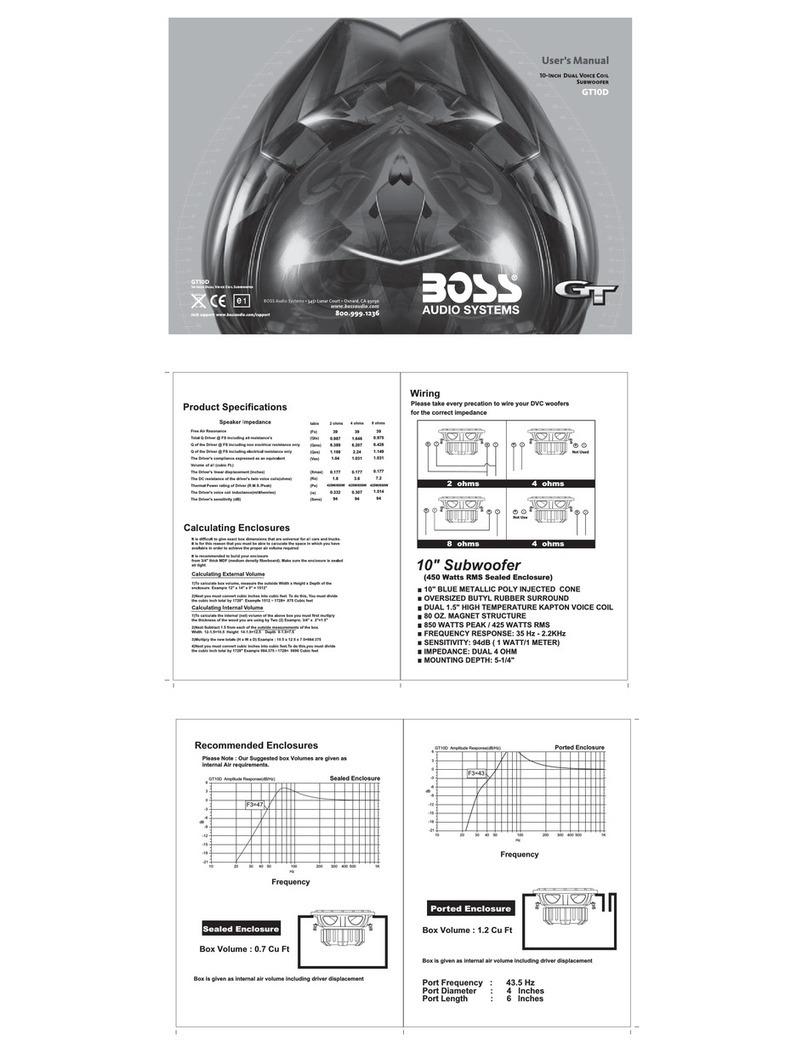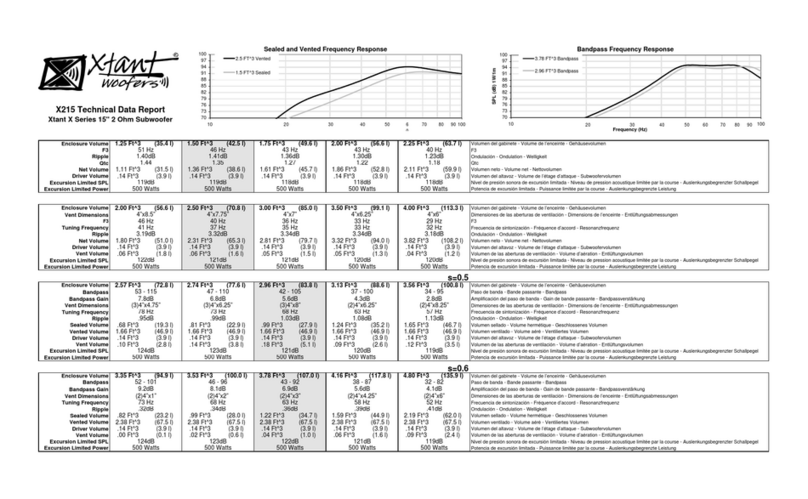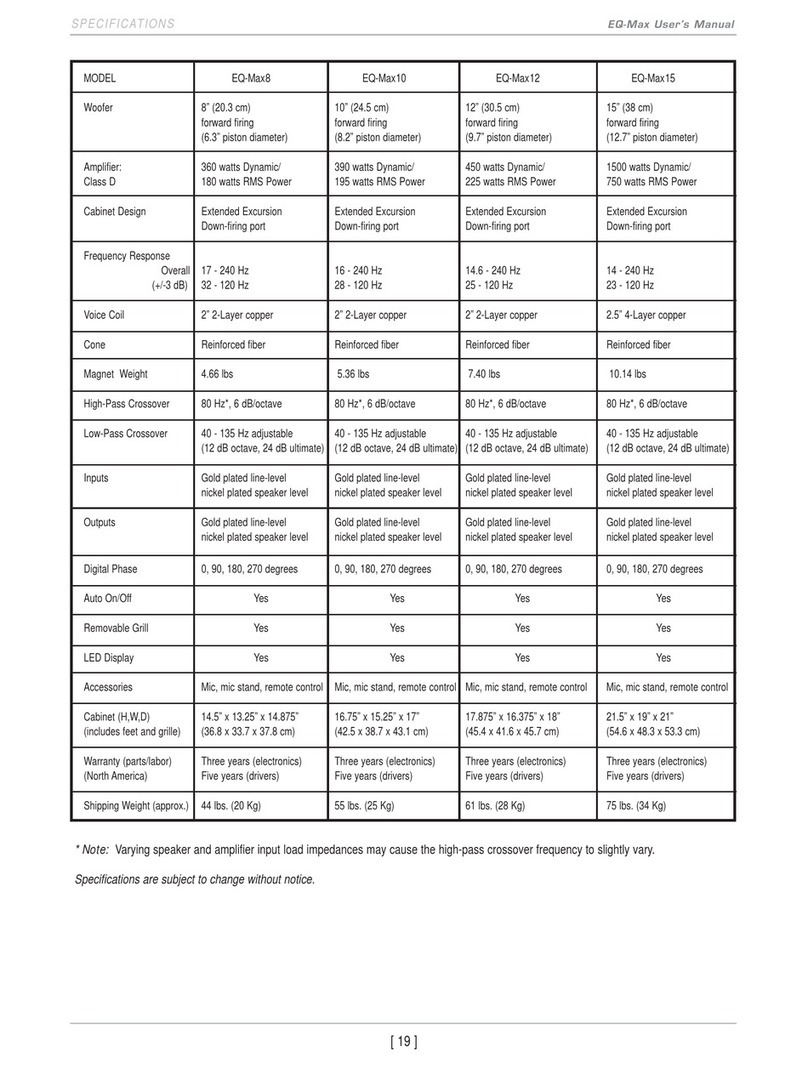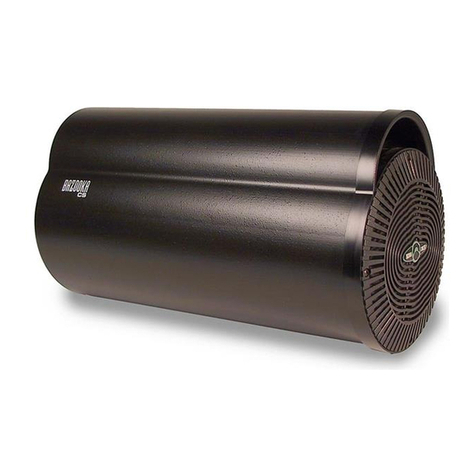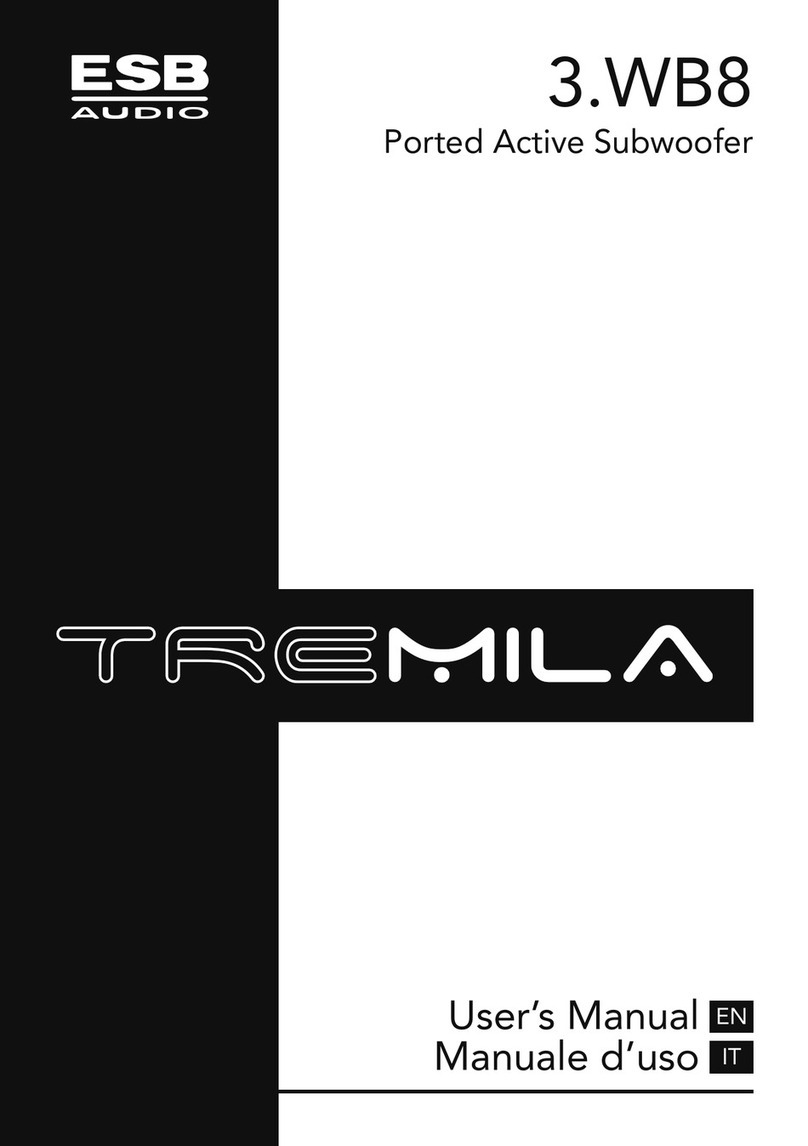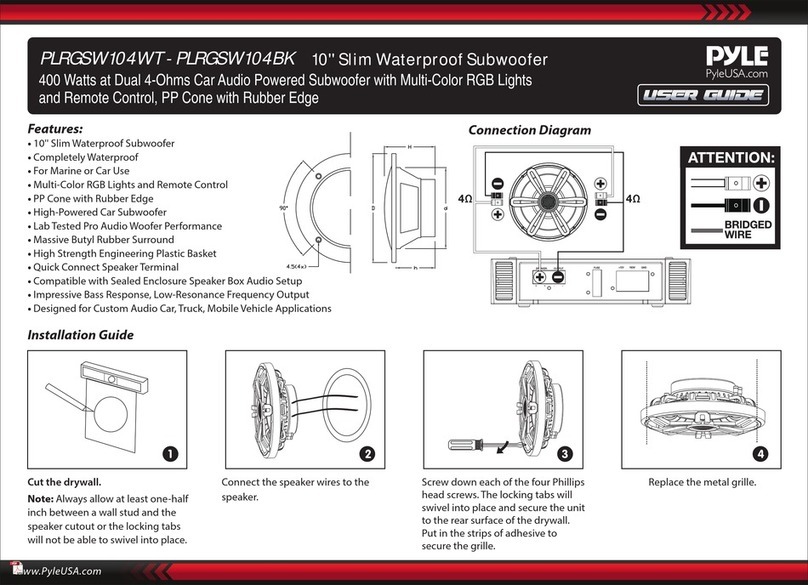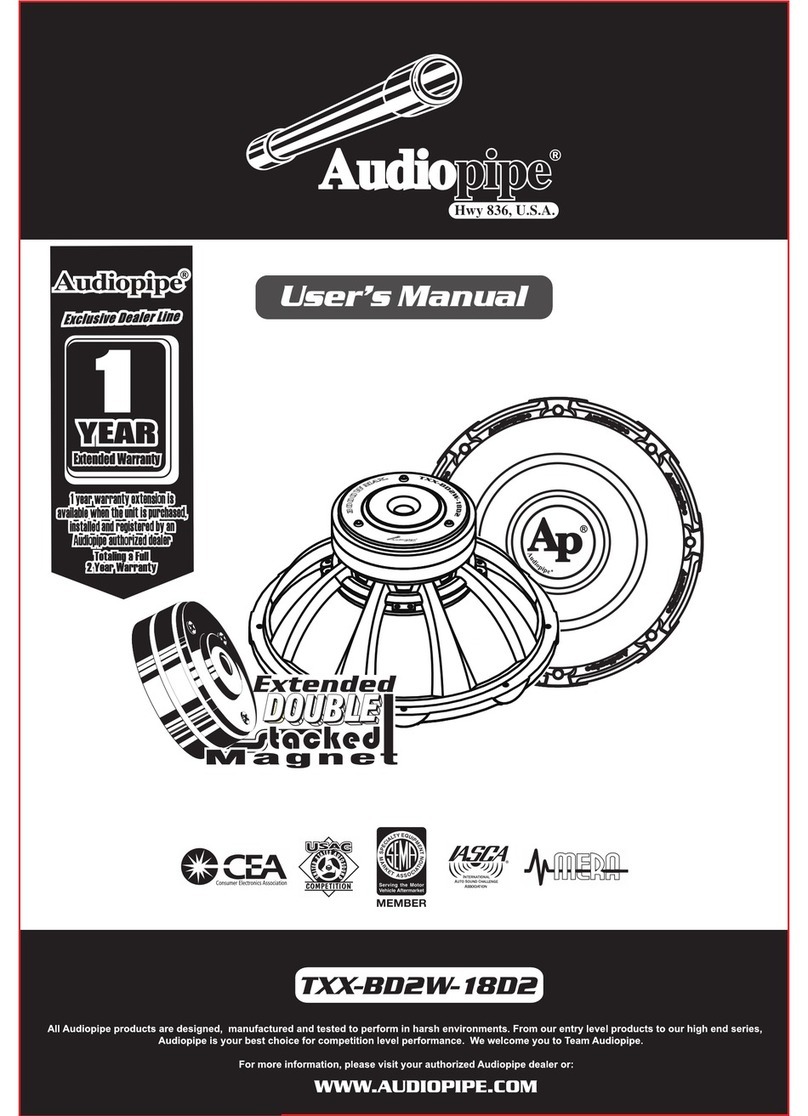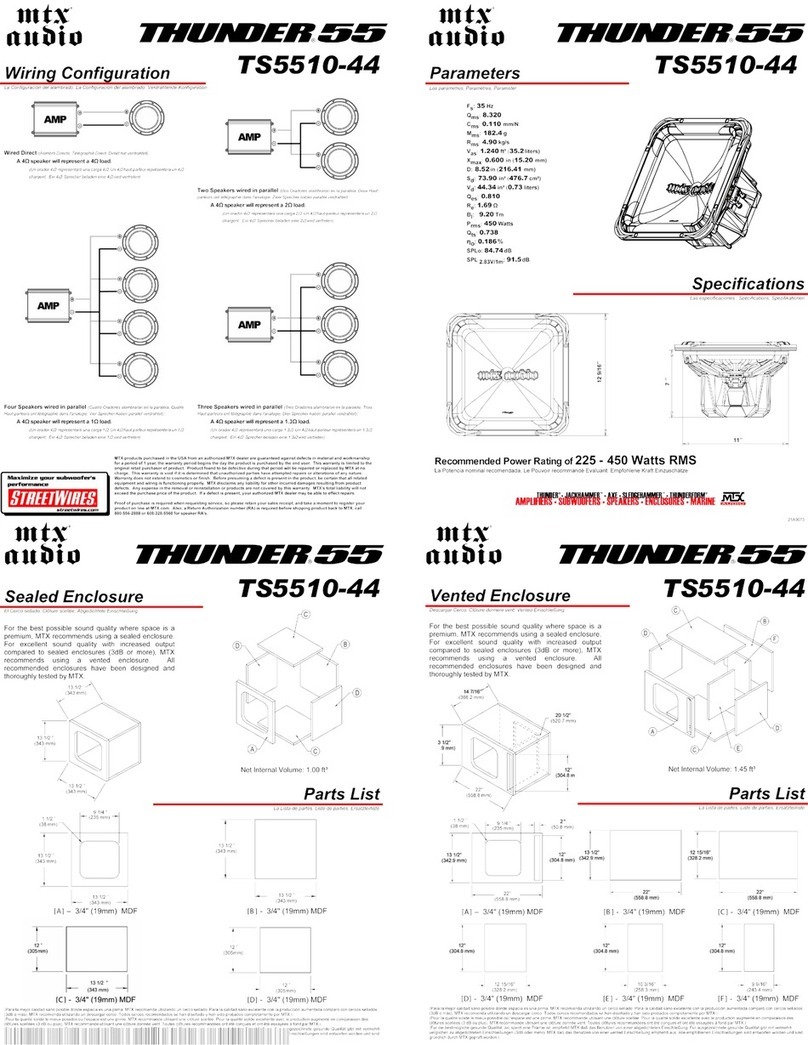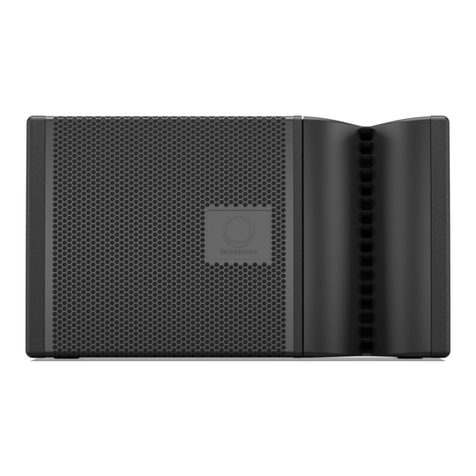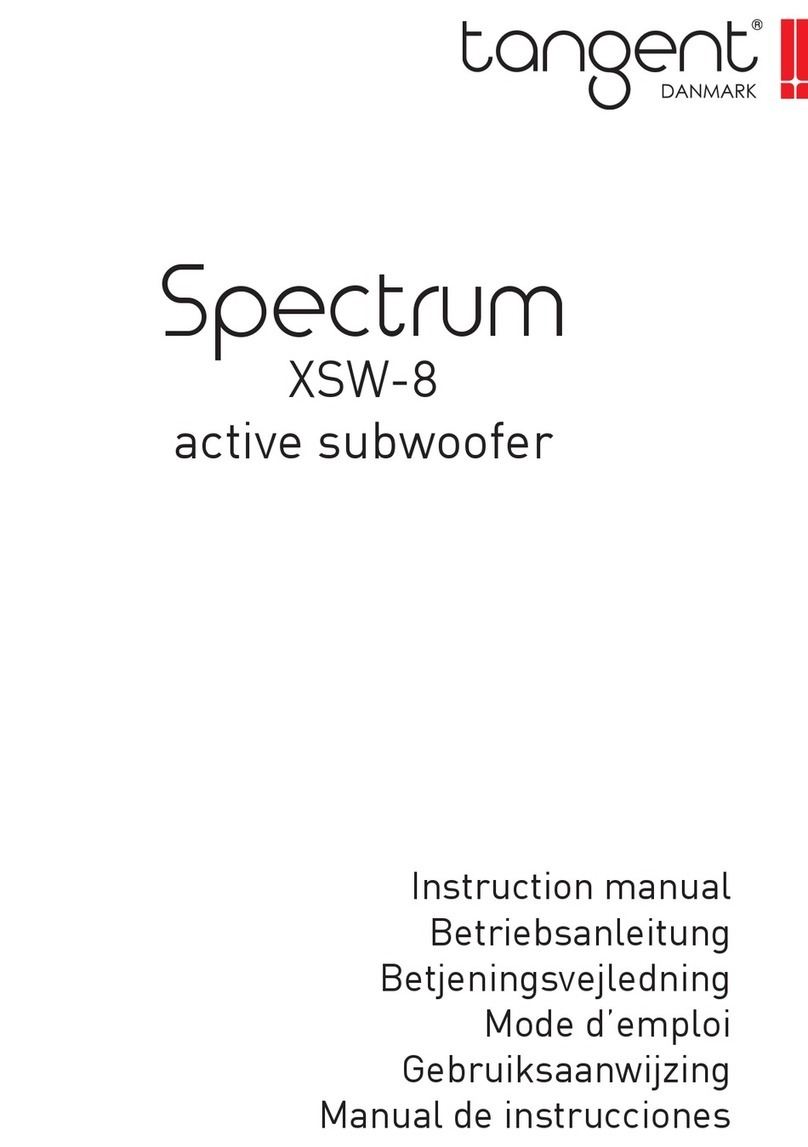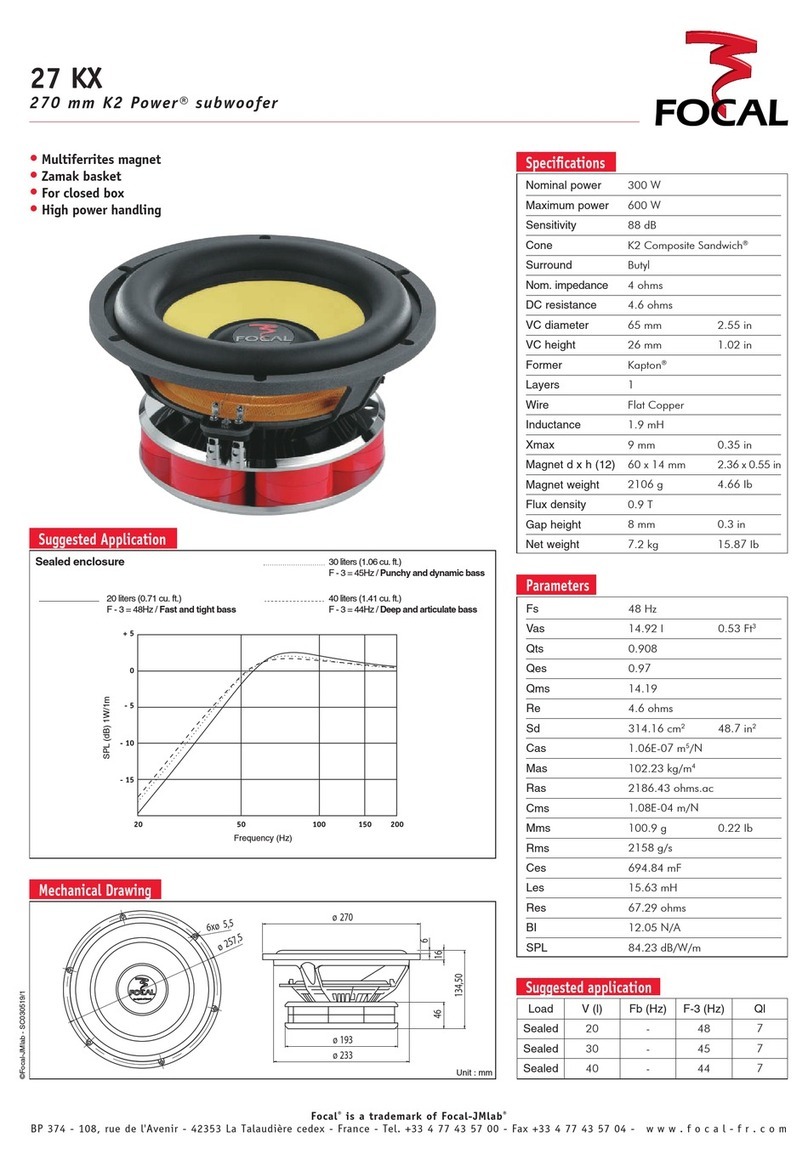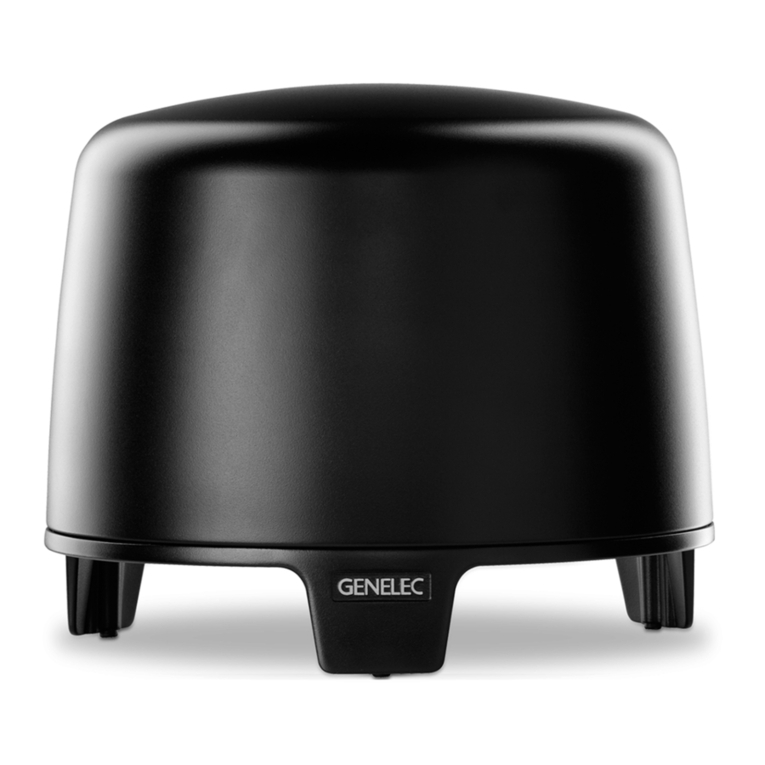TheLoudest.com Competition Pro TL-1121 User manual

All content © Copyright TheLoudest.com 2007
OWNER’S
MANUAL
HIGH PERFORMANCE
12” SUBWOOFER
DUAL 2 OHM VOICE COIL
3,000 Watts Max
1,000 Watts RMS
SAFETY GUIDELINES | TECHNICAL SPECIFICATIONS
FEATURES | INSTALLATION AND OPERATION INSTRUCTIONS

Introduction
Congratulations on your purchase of the Competition Pro TL-1121 subwoofer.
After huge amounts of careful and detailed research, design, development and testing,
TheLoudest.com proudly present this stunning subwoofer packed with revolutionary features
using state of the art components and materials.
The Competition Pro TL-1121 is a 12" competition grade heavy-duty subwoofer designed to
pound out deep, ultra low sub-bass which is nothing short of accurate in definition. The TL-
1121 subwoofer has a durable, precision-engineered, robust build that offers fantastic bass
reproduction, and maintains such clear bass reproduction at uncompromisingly high power
levels.
For every day-listening, installing the TL-1121 in a sealed enclosure (such as TL-1120) will
result in high fidelity reproduction over the entire bass frequency range, suited to most
types of music, giving audiophile quality sound.
For extreme listening or SPL competitions, installing the TL-1121 in a ported enclosure (or
simply removing the plug on the TL-1120 enclosure) unlocks the full potential of the woofer,
resulting in pure subsonic power of monstrous proportions, ensuring the TL-1121 hits the
hardest, deepest and loudest bass, blowing away just about anything that dares to stand in
its path.
It is imperative that you read through this manual before installing and operating the
subwoofer. This will ensure correct configuration and operation. While this manual details
generally how to install the subwoofer, if you do not have sufficient experience or tools, it is
best to have it professionally installed.
This subwoofer functions best in a system with a good quality source unit. Connecting it up
to a system which includes a poor quality source unit (such as a standard, factory fitted one)
may not give good results.
The input power handling of the TL-1121 is 3,000 watts max. (1,000w RMS). The amplifier
used to power the TL-1121 (the TL-1023 is recommended) can draw very large currents
from the vehicle battery and alternator. Depending on vehicle model, one or more of these
components may have to be replaced to enable the amplifier to operate to its full potential.
For further details regarding this, please refer to the amplifier manual.
TheLoudest.com accepts no liability for any damage resulting to vehicle components when
installing or operating the TL-1121 subwoofer. It is the sole responsibility of the user to
follow these instructions carefully and upgrade any vehicle components as required.
Again, if you do not have sufficient experience or tools, it is best to have the unit
professionally installed.
Keep this manual in a safe place so it is accessible for future reference.
OWNER’S MANUAL
OWNER’S MANUAL
Contents
Page
Introduction .................................................................... 2
Features ......................................................................... 3
Technology ..................................................................... 3
Configuration .................................................................. 4
Enclosures ...................................................................... 6
Calibration ...................................................................... 7
Mounting Instructions ...................................................... 7
Safety ............................................................................ 8
Troubleshooting .............................................................. 9
Technical Specifications .................................................... 10
OWNER’S MANUAL

OWNER’S MANUAL
Configuration
The TL-1121 subwoofer comes with dual 2 ohm voice coils. This enables the user/installer
to connect one TL-1121 subwoofer to an amplifier in either of the following two ways:
1. Parallel – Recommended (See fig. 1 below).
- Connect the negative terminal of the amplifier to both the negative terminals of the
subwoofer.
- Connect the positive terminal of the amplifier to both positive terminals of the
subwoofer.
Connecting the TL-1121 2 ohm voice coils in parallel like this gives a load of 1 ohm to
the amplifier. The maximum output of the amplifier at 1 ohm should be around
3,000w max and 1,000w RMS but no more. The Competition Pro TL-1023 Class D
Monoblock Subwoofer Amplifier (3,000w max and 1,000w RMS @ 1 ohm) is strongly
recommended.
2. Series – Not Recommended (See fig. 2 below).
- Connect the negative terminal of the amplifier to the negative terminal of one of the
voice coils (left one for example).
- Connect the positive terminal of that voice coil (left) to the negative terminal of the
other voice coil (right).
- Connect the positive terminal of the amplifier to the positive terminal of that voice
coil (right).
Connecting the TL-1121 2 ohm voice coils in series like this gives a load of 4 ohm to
the amplifier. This is not normally favourable as the parallel configuration gives a
lower load impedance, getting more from the amplifier.
If mounting the woofer outside the enclosure, pointing in, the connections will be made
straight to the amplifier. If mounting the woofer inside the enclosure, the connections will
be made via the terminal block on the side of the subwoofer box. The Competition Pro TL-
1120 enclosure is recommended, as it has been manufactured to match the TL-1121 and
allow the woofer to perform to its full potential.
Fig. 2 – TL-1121 subwoofer connected in
series, giving 4 ohm load to amplifier.
Not normally recommended.
Fig. 1 – TL-1121 subwoofer connected in
parallel, giving 1 ohm load to amplifier.
TL-1023 amplifier recommended.
Technology
The TL-1121 subwoofer boasts extraordinarily high cone excursion with extreme linearity
and a simultaneous super-efficient heat discharge system. An overview of some of the
innovative, cutting edge patent pending theloudest.com technology implemented in this
subwoofer is as follows:
·Symmetrical Magnetic Drive (SMD).
Focuses on a unique piston technique that generates immense momentum drive, far
greater than conventional designs.
·Direct coupling advanced layer bonding (DECAL).
Generates superior strength magnetic flux from the magnet to the voice coils, relentlessly
delivering huge amounts of power. A specially extended top plate layer draws and directs
the optimum strength of magnetic flux from the magnet to the voice coil. Subsequently,
the internal pole piece draws and concentrates the flux from across the air gap to the back
plate, as a result, depositing immense flux in the lower air gap plate.
There are three layers that make up the complete DECAL structure, each possesses a high
permeability of magnetic flux. The upper and lower layers double up as efficient heat
dispersers as well as generating flux. The thicker centre layer is where magnetic energy
flow is maximised.
·Airborne Heat Relief System (AHERS).
Efficiently transfers and dissipates heat to the outer massive heat-sink. This allows the
voice coils to consume more heat energy and to ultimately reproduce more power.
As the predominant force resulting from the symmetry pushes the woofer up, further
momentum is gained at the lower air gap plate in driving the cone back down to its original
position. When driven like this to full potential, in conventional woofers, the output is
quickly capped as the woofer is strangled by accumulated heat in the air gap and voice coils.
In the TL-1121 though, the DECAL and AHERS systems ensure that this doesn’t happen.
Heat is efficiently dispersed out through the upper and lower DECAL layers to the massive
outer heat sink chassis fast enough to allow more current to pass through the coils again.
The AHERS allows more cool air to replace the warm air through the entire vented pole
piece. These two systems alone enable the woofer to consume extraordinarily higher
amounts of current, therefore allowing the woofer to perform to uncompromisingly high SPL
levels.
OWNER’S MANUAL
Features
·Ultra strong, rigid hybrid Kevlar fibre cone. Comprehends the seriousness of competition
rigors and the strict demand of audiophile quality reproduction.
·Progressive high linearity spider. Provides excellent suspension during extreme SPL.
·Competition grade 4-layer Kapton voice coils. Provide extra high power handling.
·Gigantic magnet assembly. Composed of high density Strontium-Ferrite.
·Carbon-graphite enhanced density pure Aluminium die-cast frame and structure.
·Lead wires integrated into the damper for high reliability and efficient power transfer.
·24K Gold plated non-rust high conductance all-metal hexagonal lock tight binding post
input terminals.

OWNER’S MANUAL
Enclosures
There are two main types of enclosure to choose from when installing the TL-1121; sealed
or ported.
Sealed enclosure (See fig. 5 below).
A sealed enclosure gives a “tighter”, more “punchy” response, over the whole bass region.
This is recommended for every-day listening as it works well with most types of music.
This enclosure design gives best overall frequency response and certainly is recommended
for users preferring SQ (sound quality) to SPL (sound pressure level).
Ported Enclosure (See fig. 6 below).
A ported enclosure gives significantly more SPL, however, this is concentrated on a smaller
band of bass frequencies. This is recommended for SPL competitions and for music genres
such as rap, hip-hop, r&b, drum&bass, or other bass-heavy music.
TheLoudest.com manufacture a black vinyl covered enclosure, “Competition Pro TL-1120”.
This has been designed and fine tuned to the TL-1121 subwoofer in order to achieve the
best SPL and SQ. The TL-1120 is the first production enclosure that has a removable plug
over the port. This revolutionary feature allows the user to swap between sealed design and
ported design. For every-day listening, the plug can be installed, so the sealed enclosure
design is utilised, and for SPL competitions, the plug can be removed.
Other features of the tailor-made TL-1120 include the extended design, allowing enough
mounting depth for the woofer, and the unit being substantially re-enforced to allow the
mounting of the heavy TL-1121 subwoofer either facing in towards the enclosure, or inside
the enclosure facing out.
Constructing a custom enclosure for the TL-1121 subwoofer is only recommended for
seasoned professionals.
If this is the case, the minimum sealed enclosure volume should be 1.2 ft³ with the
recommended sealed enclosure volume being 2.2 ft³.
The minimum ported enclosure volume should be 1.5 ft³, with the recommended ported
enclosure volume being 2.2 ft³.
Installing the TL-1121 into an enclosure that is smaller than the minimum volumes specified
means that subwoofer will not work to its full potential and can be placed under a lot of
stress which could result in permanent damage.
The TL-1121 subwoofer can be installed as part of club/pa systems by professionals.
Fig. 6 – The TL-1121 subwoofer installed in a
ported enclosure.
Fig. 5 – The TL-1121 subwoofer installed in a
sealed enclosure.
OWNER’S MANUAL
When connecting two TL-1121 subwoofers together, the user/installer can connect the
subwoofers to an amplifier in either of the following two ways:
1. Parallel-Series (See fig. 3 below).
- Connect the negative terminal of the amplifier to the negative terminal of the left
voice coil of each subwoofer.
- Connect the positive terminal of the amplifier to the positive terminal of the right
voice coil of each subwoofer.
- For each woofer, connect the positive terminal of the left voice coil to the negative
terminal of the right voice coil.
2. Series-Parallel (See fig. 4 below).
- Connect the negative terminal of the amplifier to both the negative terminals of the
first subwoofer.
- Connect the positive terminal of the amplifier to both the positive terminals of the
second subwoofer.
- Connect the positive terminals of the first woofer together.
- Connect the negative terminals of the second woofer together.
- Connect the two above connections to each other.
Connecting two TL-1121 subwoofers to an amplifier in either of the above two methods
gives a load of 2 ohm to the amplifier. The recommended way to do this is to use two
Competition Pro TL-1023 Class D Monoblock Subwoofer Amplifiers (6,000w max and 2,000w
RMS @ 2 ohm when combined in bridge mode). The only difference between the above two
methods is the way in which they are connected, simply choose which one can be most
easily implemented in your situation.
If mounting the woofers outside the enclosures, pointing in, the connections can be made
straight to the amplifier. If mounting the woofers inside the enclosures, the connections will
be made via the terminal block on the side of the enclosure. With either method of
mounting, it is recommended that the terminal blocks on the side of the enclosure are
utilised to make the connection to the amplifier easier. Please refer to the manual supplied
with the enclosures for further information on connecting the amplifier to the subwoofers
through the terminal blocks on the side of the enclosure.
Fig. 4 – Two TL-1121 subwoofers connected in
series-parallel, giving 2 ohm load to amplifier.
Two TL-1023 amplifiers are recommended.
Fig. 3 – Two TL-1121 subwoofers connected in
parallel-series, giving 2 ohm load to amplifier.
Two TL-1023 amplifiers are recommended.

OWNER’S MANUAL
OWNER’S MANUAL
Calibration
Safety
How to calibrate the amplifier and subwoofer with the source unit:
Health Warning
1.
Turn the gain knob on the amplifier all the way down
The Competition Pro range of car audio is built for very high power handling. Listening to
2.
Play a CD or similar of music or audio that will be typically played
music at such high powers is potentially capable of causing physical side effects such as
3.
Turn the gain control on the source unit to around 70
– 80% of it’s maximum
nausea or even permanent side effects such as hearing loss. It is therefore absolutely
4.
Slowly increase the gain knob on the amplifier until the sound reaches the desired
essential that conservatism and a high sense of judgement is observed when in operation.
level.
TheLoudest.com accepts no liability for hearing disorders, nausea or other side effects
5.
If distortion is present, turn the gain knob on the amplifier to just before this
caused by this equipment.
distortion occurs
6.
Test the system and make any equalisation changes on the source unit or the
General Safety
amplifier according to taste
Playing loud music in a vehicle can hinder your sense of what is going on around you on
7.
If any equalisation changes are made, repeat stages 1 to 7 until satisfied
the road, including your ability to hear your own, and other vehicles. We recommend
8.
Never exceed the source unit gain that you used to calibrate the system
listening at low or moderate levels while driving.
TheLoudest.com accepts no liability for injury, property damage or otherwise resulting
Remember:
from the use or misuse of this equipment.
-
It is possible for the gain knob to be at only a quarter of its maximum, but the
amplifier is actually outputting to its full potential. This could be because the source
Do not use any chemicals when cleaning this equipment. Please use a clean dry cloth.
unit is supplying slightly more power than normally expected.
-
Always turn the gain down or off if you can hear distortion.
Do not install this unit outside the car, or anywhere where it could become damp or humid,
-
No matter how robust or powerful a subwoofer is designed to be, any speaker’s
or where it can become exposed to the sun. It should be installed in a dry and ventilated
mechanical structure is physically susceptible to damage if played for a prolonged
area inside the car.
period of time in an over-driven state. To avoid this, never use an amplifier which
has RMS output values in excess of the rated RMS input values of the subwoofer or
Never connect or disconnect the subwoofer when the amplifier is on; this can permanently
combination of subwoofers.
damage the subwoofer. Always do this when it is off.
-
Always ensure that the load impedance (in ohms) provided by the subwoofer is never
lower than the minimum load impedance (in ohms) of the amplifier. Connecting a 1
Never open the amplifier up. Doing so would put you at risk of an electric shock. None of
ohm load to an amplifier that has a minimum load of 4 ohm bridge for example, can
the internal parts are serviceable by the user. In the case of the unit needing repair or
result in permanent damage to the amplifier and/or subwoofer.
maintenance, please take it to a qualified professional.
-
Avoid using amplifiers that have significantly lower RMS output values than the RMS
input rating of the subwoofer. This can result in the amplifier producing distortion as
it is being worked very hard. This means that the audio is distorted before it reaches
the subwoofer and can damage the subwoofer permanently.
Mounting Instructions
As illustrated to the right of this text, the TL-1121 subwoofer
can be mounted either inside the enclosure facing outwards
(top diagram) or outside the enclosure facing inwards
(bottom diagram).
Position the woofer in place and mark the position of the
mounting 8 points onto the enclosure. It is advisable to use a
1 or 2 mm drill bit to make “pilot holes” before replacing the
woofer and using self-tapping screws (not supplied) to secure
the woofer in place. If mounting the woofer inside the box, it
is important to ensure the audio leads are connected to the
woofer before securing it in place.

OWNER’S MANUAL
OWNER’S MANUAL
Troubleshooting
Technical Specifications
Problem
Possible Cause(s)
Solution
Distorted output
Source unit/amplifier gain set
Re-calibrate amplifier with source unit
Competition Pro TL-1121 dual 2 ohm voice coil
12” Subwoofer specifications:
too high
Parameter
Data
Unit
Info
Source unit is not capable of
Replace/upgrade source unit
Nom. diameter
12
[inch]
Nominal diameter (30 cm)
good audio reproduction
Vas
54.957
[Litres]
Equivalent volume
Qts
0.807
Total Speaker Q-factor
Speaker(s) blown
Disconnect speakers one at a time to
Qes
0.905
Electrical Q-factor
pinpoint defective speaker
Qms
7.339
Mechanical Q-factor
Fs
21.935
[Hz]
Resonance Frequency (Free Air)
Enclosure too small
“Encl
Replace encl
osures” secti
osure for l
on of
arger
manual
one (se
for furthe
e
r
Sensitivity
90.659
[dB]
SPL dB at 1W, 1m
information).
Max Power
3000
[W]
Maximum input power
RMS Power
1000
[W]
RMS input power
Bass is weak
Dual voice coils on subwoofer
Try swapping over + and – on one of the
xmax
20.32
[mm]
Max excursion from centre at normal operation
wired out of phase
voice coil connections
(one way)
Moving mass
278.9
[g]
(Mms) Weight of moving parts
Bad speaker connections
Check speaker connections at subwoofer
Disp area
0.0434
[m2]
(SD), Effective piston area of cone
and amplifier ends
Disp Vol
1763.8
[cm3]
Displaced volume = xmax x 2 x SD
Coil diameter
76.4
[mm]
Diameter of the voice coil (Kapton 4-layer - 3")
Subwoofers connected out of
Check the + and – connections all match,
Cms
0.1888
[mm/N]
The stiffness of the driver’s suspension
phase
swap to test
Magnet weight
5102.9
[gr]
Weight of the magnet (180 oz)
Re
1.785
[ohm]
DC resistance (per voice coil)
Eq settings are reducing bass
Verify all eq settings on amplifier and
Z
2
[ohm]
Impedance of coil (per voice coil)
power
“LPF” sett
source uni
it, especi
ngs on am
ally “sub
plifier
sonic” and
L
Bl
27.529
2.23
[Tm]
[mH]
Inductan
Magnetic strength (
ce of coil (per coil
Motor forc
@ 1 kHz)
e factor)
Poor quality amplifier
Use TL-1023 for one TL-1121
Recommended sealed
0.0623
[m3]
(2.2 cubic feet)
Use 2x TL-1023s for two TL-1121s.
enclosure
Minimum sealed enclosure
0.034
[m3]
(1.2 cubic feet)
Recommended ported
0.0623
[m3]
(2.2 cubic feet)
enclosure
If your subwoofer is still not functioning correctly after checking through the
Minimum ported enclosure
0.0425
[m3]
(1.5 cubic feet)
“troubleshooting” section, please contact our support team at:
Krm
2
[m]
Kxm
2.58
[mH]
Rem
5.31
Erm
0.984
Exm
0.656
P max
3,000
Watts
Maximum peak input power
P rms
1,000
Watts
Maximum RMS input power
Magnet material
High density strontium-ferrite
Cone/dust cap material
Dynaflex
Surround material
Santoprene Rubber
Aluminium shorting ring
Yes
Heat sink
Yes
Mounting depth
282 mm
Table of contents
Popular Subwoofer manuals by other brands
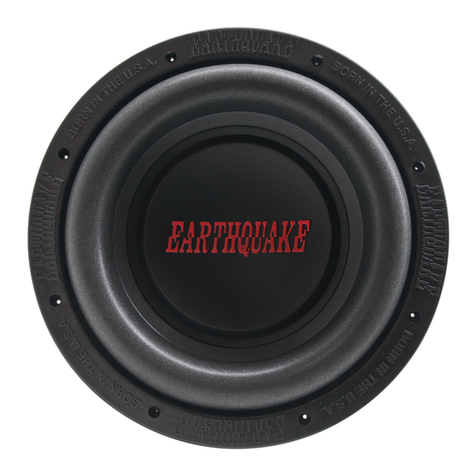
EarthQuake
EarthQuake DB-10 Installation & reference manual
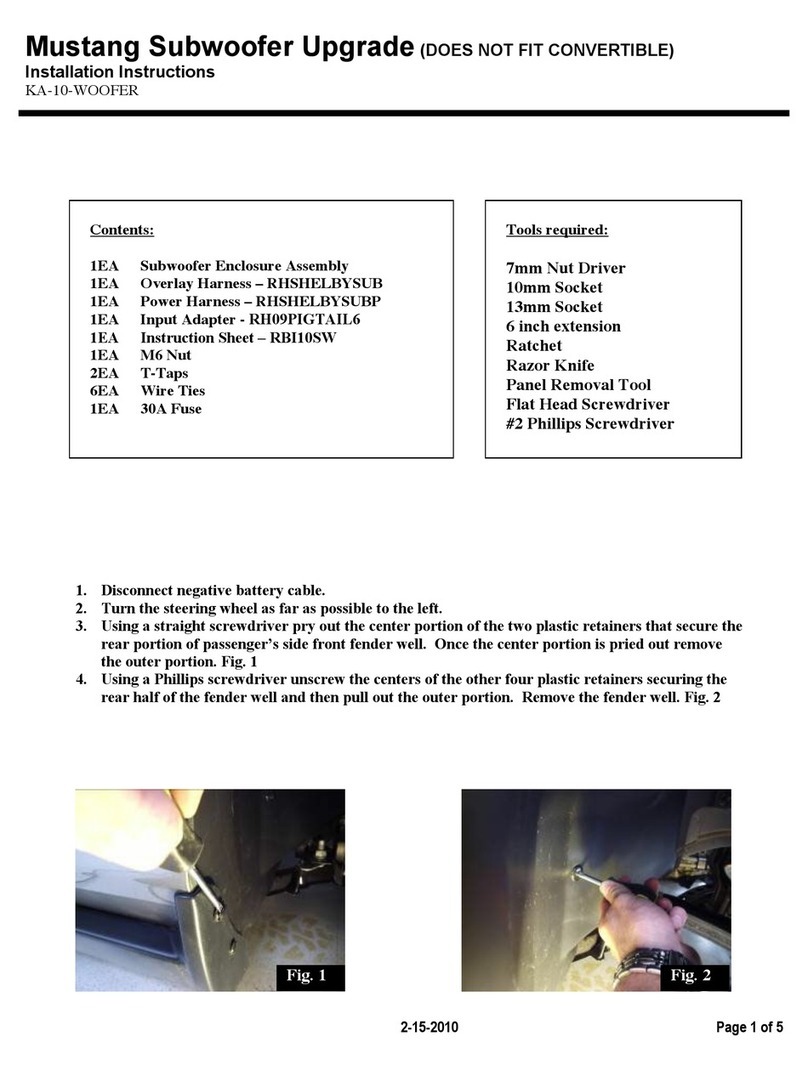
Kicker Audio
Kicker Audio KA-10-WOOFER installation instructions
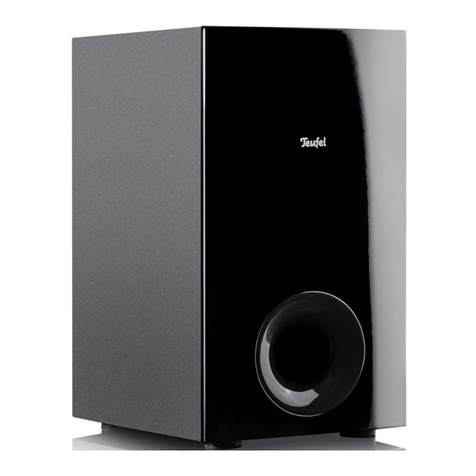
Teufel
Teufel IP 3000 SW operating instructions
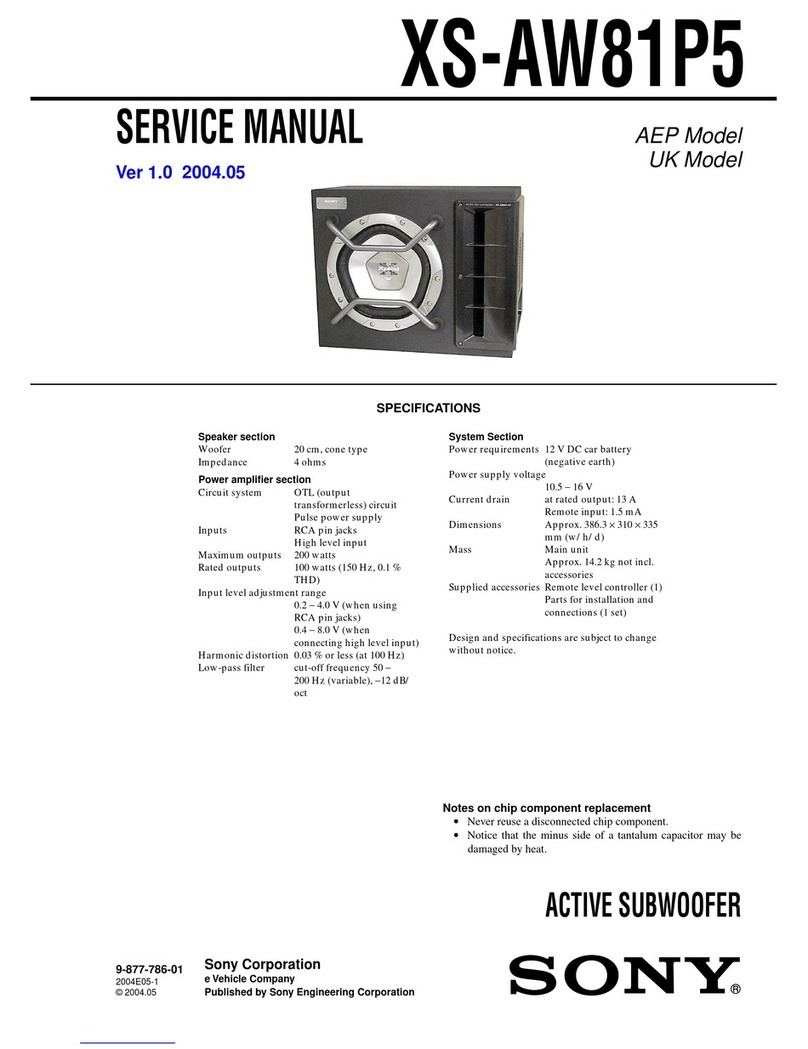
Sony
Sony XS-AW81P5 Service manual

Pyle Pro
Pyle Pro PDW18125 owner's manual
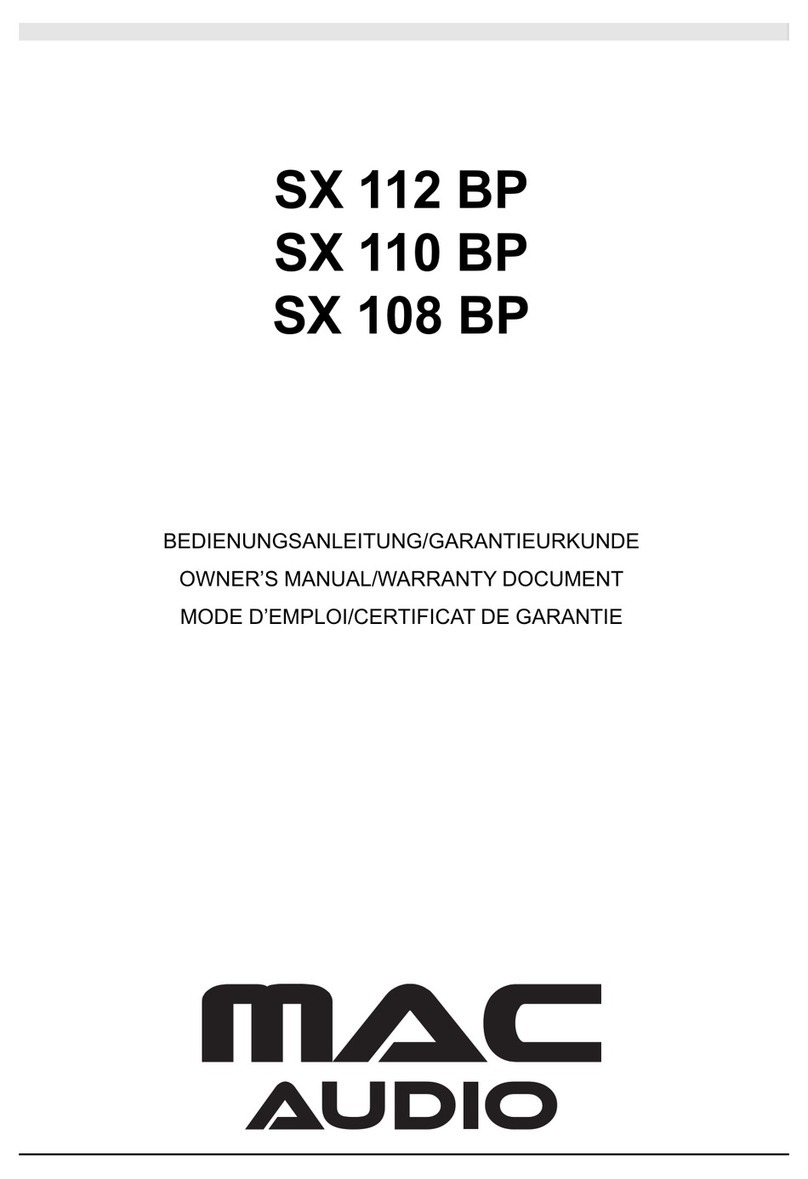
MAC Audio
MAC Audio SX 112 BP Owner's manual/warranty document
